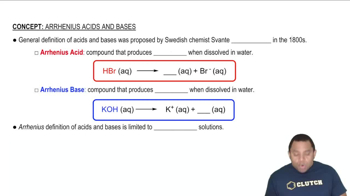Textbook Question
What is the pH of a solution in which 224 mL of HCl(g), measured at 27.2 °C and 1.02 atm, is dissolved in 1.5 L of aqueous solution?
 Verified step by step guidance
Verified step by step guidance



What is the pH of a solution in which 224 mL of HCl(g), measured at 27.2 °C and 1.02 atm, is dissolved in 1.5 L of aqueous solution?
Determine the [H3O+] and pH of a 0.100 M solution of benzoic acid.
Determine the pH of an HNO2 solution of each concentration. In which cases can you not make the simplifying assumption that x is small? a. 0.500 M b. 0.100 M c. 0.0100 M
Determine the pH of an HF solution of each concentration. In which cases can you not make the simplifying assumption that x is small? (Ka for HF is 6.8×10–4.) a. 0.250 M b. 0.0500 M c. 0.0250 M